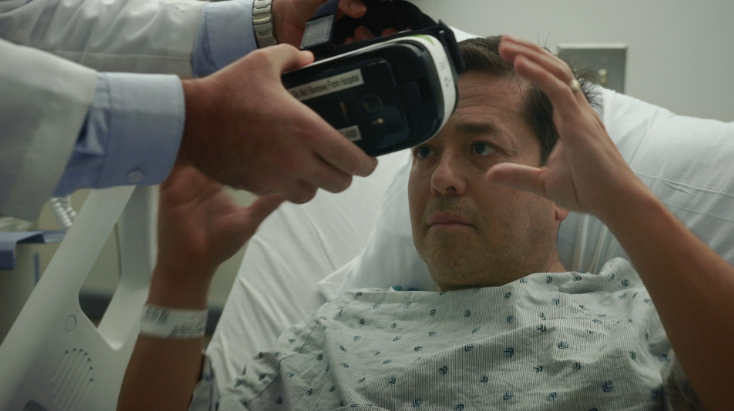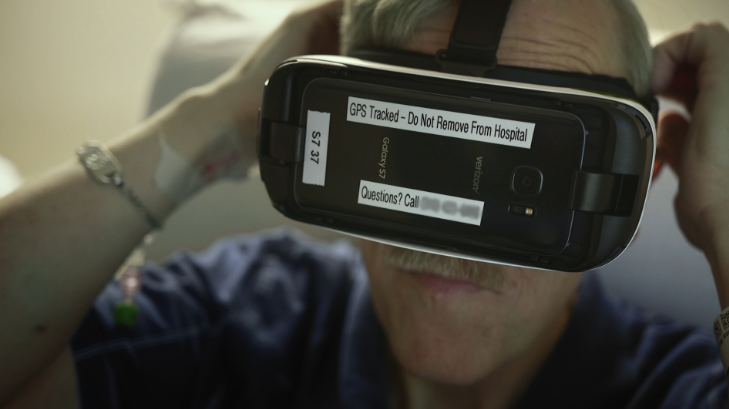
The patient tried on VR glasses for the first time
David Nicholson/Bloomberg
Deona Duke was a 13-year-old girl. When she and her friends were playing around the campfire one day, unfortunately it happened: The bonfire exploded and the sudden fire burned her into a fire. After waking from a coma, Duke had to accept the fact that he had a one-third burn in his body and started his long rehabilitation. However, the road to recovery is quite difficult. To prevent infection, the doctor will change her gauze every day. Each time the gauze is replaced, it will bring a layer of skin every time. Sometimes even if it is morphine, it will be hard to bear. The degree of pain can be Want to know.
Patient's analgesic
During the healing process, the Duke's attending doctor gave her a VR headset one day. Bringing on the VR helmet, the little girl immediately immersed in the "ice and snow world", she can make snowmen, snowball fight as much as she likes, temporarily forget the pain caused by illness.
This Texas hospital has also become one of the few pilot units that rely on virtual reality technology to alleviate the suffering of patients.
"I've never heard of virtual reality before, so I'm surprised," Duke said. "But when I put on it, I really will turn my attention elsewhere, so that doctors don't have pain in changing gauze. "
Reliance on VR technology to reduce the pain is still in the experimental stage, but VR supporters believe that it is indeed an effective treatment, can be applied to pain, Alzheimer's disease, phobia and depression and other diseases. In addition, as major technology companies invest heavily in the VR field, their hardware and software costs are gradually reduced, and they can completely become new alternatives to the hospital.
There is also sufficient theoretical support for VR to relieve pain: after entering the virtual world, excessive sensory input can control the way people think and work, shift people's attention to illness, and relieve pain.
"Pain is also a protection mechanism. When your body is hurt, it will scream like an alarm clock and draw your attention," said Beth Darnall, painkiller specialist at Stanford. Stanford has done a lot of clinical research using VR technology. It really can be regarded as a psychological analgesic tool that "can calm down the nervous system and suppress the pain."
The two young psychologists studied the important role of VR technology at the Brotherhood Hospital of the Holy Land. The results they obtained are similar to those of Dr. Dave Patterson of the Burn Center in Seattle. The patient who received the VR technique was not treated properly. Feeling really reduced. In addition to asking the patient, the doctor also scanned the patient's brain with magnetic resonance imaging (MRI). The results showed that they did not feel so much pain.
Feasibility study
At the Siddhartha Sinai Hospital in Los Angeles, Ronald Yarbrough is anxiously waiting. From time to time he looks at the apron of the hospital. He will fly a helicopter with a donated heart after a while. Previously, Yarbrough had used an artificial heart, but the artificial heart had already begun to fail. Now he can only rely on machines to sustain his life.
In order to alleviate the psychological pressure of Yarbrough, the doctor gave him a Samsung Gear VR. The company named AppliedVR also created a software specifically for him, hoping to help him forget the fact that he was in a small ward. This kind of effect is quite good. After Yarbrough said that he took a VR helmet, his muscles were more relaxed and his pain was relieved.
"I took a lot of painkillers. Now, my pain is reduced a lot by diverting attention." The 54-year-old truck driver said that he would also buy a VR helmet after retirement. "This guy surprised me and I don't think it works."
Supporters of VR technology think it is much better than painkillers, and it will not be addicted to long-term use. However, VR's analgesic effect still needs further study. After all, many patients in the world are suffering from chronic pain. These people cannot always wear VR helmets all day long.
“Before the VR technology was born, people generally relied on hypnosis, yoga and meditation to alleviate the pain. VR is very promising, but it is premature to conclude.†Houman Danesh said, he is a comprehensive pain at Mount Sinai Hospital in New York. Director.

Ronald Yarbrough is trying on VR glasses
David Nicholson/Bloomberg
Before the concept of VR is the best analgesic is widely accepted by the general public, we still need a lot of research. Dr. Brennan Spiegel of Sidas Sinai Hospital is preparing to spread the study to more patients. Through research, he found that older patients had some resistance to VR technology. A dying patient chose to refuse VR helmet treatment, and a female patient bought a VR helmet immediately after returning home.
"As a scientist, I was very eager to figure out how virtual reality got so divine," said Spiegel, who witnessed more than 150 patients regaining their smiles with the help of VR technology. "VR can really influence the human brain."

Dr. Brennan Spiegel is observing a patient using VR
David Nicholson/Bloomberg
How does VR shine with medicine?
Seeing here, there are surely many readers who will ask, who is so talented with the combination of VR and pain management? In fact, this smart collision was an accident. Tom Furness is a professor in the Department of Industrial Engineering at the University of Washington. He was the first group of people in schools to come into contact with VR. Furness began to pay attention to VR 50 years ago when he served in the Air Force. He then led the development of more than 20 VR-related products. The most famous of these was a consumer-grade headset in 1993, which was due to less content. It failed, but its limited buyer included many dentists.
“The dentist loved the headset because the patient complained less after wearing it,†Furness said. "Give your child extra teeth to work harder."
This moment is the source of sparks in VR and medicine, and people began to study this phenomenon. However, like Furness encountered, the price of VR devices has become a barrier to its popularity. Initially, VR devices for medical treatment cost as much as $35,000.
However, this situation will be completely changed this year. VR devices are flying into the homes of ordinary people from the geek studios, and their prices are bound to drop substantially.
Hospitalization is the bulk of medical expenses. It can account for 30% of the US$3 trillion in medical expenditures each year in the United States. Therefore, compared with the cost of hospitalization, the expenditure on hardware and software for VR devices can only be considered drizzle. As long as it can prove that the VR device has miraculous effects on pain relief, he will be very attractive to the hospital. In addition to the above-mentioned AppliedVR, a startup company named DeepStream VR is also actively working with the hospital to develop software and systems dedicated to patients.
However, at this stage, VR is not a panacea. Due to the small content, patients will quickly become bored, and this will greatly reduce the effect of pain relief.
Via bloomberg
Recommended reading:
When AR encounters medical treatment: Let you treat while playing Pokémon GO
Is it better than opium? VR or will replace your pain medicine
Any QI enabled device like iPhone X/ 8/8Plus, Galaxy, Samsung S7,S7 Edge, S6,S6 Edge, Nexus 4/5/6 (NOTE: Other device have no wireless charging function except putting on extra receivers.)
Starts the moment you place down any Qi-enabled device or device equipped with a Qi-compatible cover. No cables or USB interface required. Input: AT LEAST 5V/2A; Output: 5V/1A
Wireless Charger,Universal Wireless Charger,Portable Wireless Charger,Mobile Wireless Charger
Shenzhen Waweis Technology Co., Ltd. , https://www.waweisasdapter.com